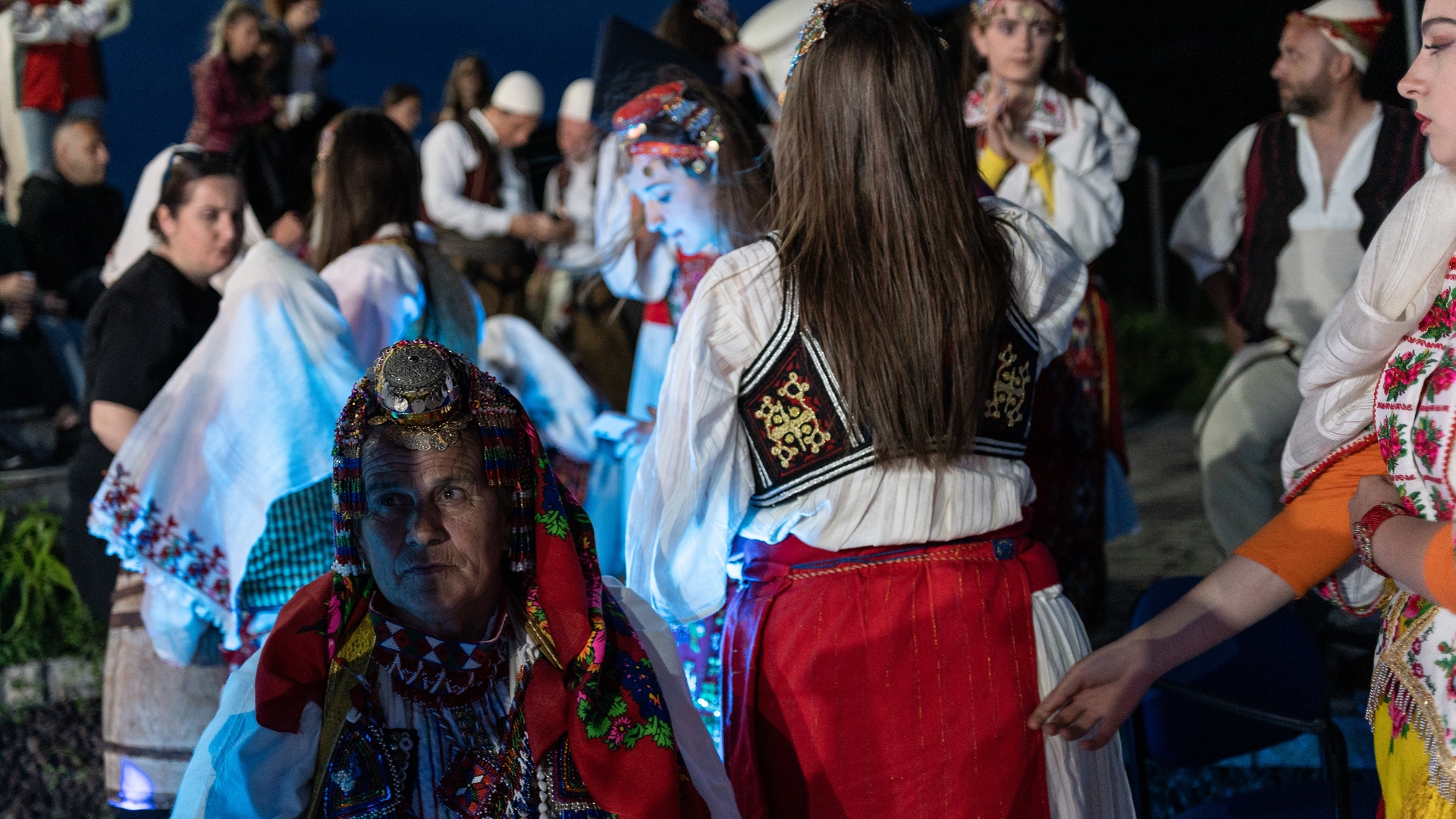
Echoes of Has over Kosovo
A festival that resonates and resists the passage of time.
By Uran Haxha | May 29 2025
The sun had already begun to set over the Pashtrik mountain range near Prizren, as children filled a football field on a hill, where the wind blew from all directions.
Cars with license plates from countries like Romania, Croatia, Serbia, Austria and others wound their way through the village of Gjonaj in Has, climbing the road toward the hill. This variety of plates revealed that Hasjans had returned to their homeland from where they lived in the diaspora — and, most likely, work as bakers or own bakeries. This is a long-standing tradition for the people of Has, and it’s rare to find a family from the area that hasn’t been involved in the bakery trade.
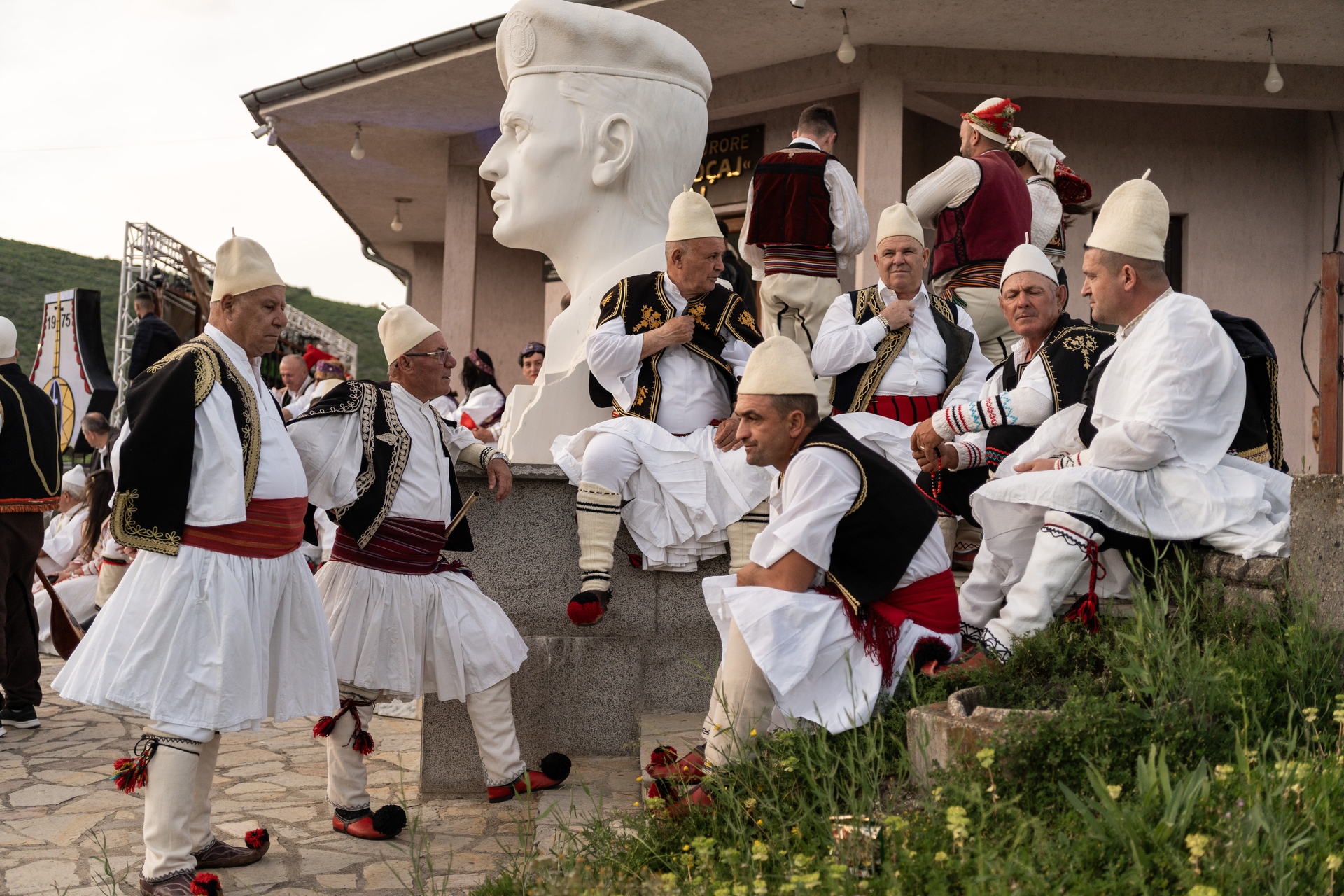
Everyone was heading uphill for the main event in the area, the Hasi Jehon folklore festival.
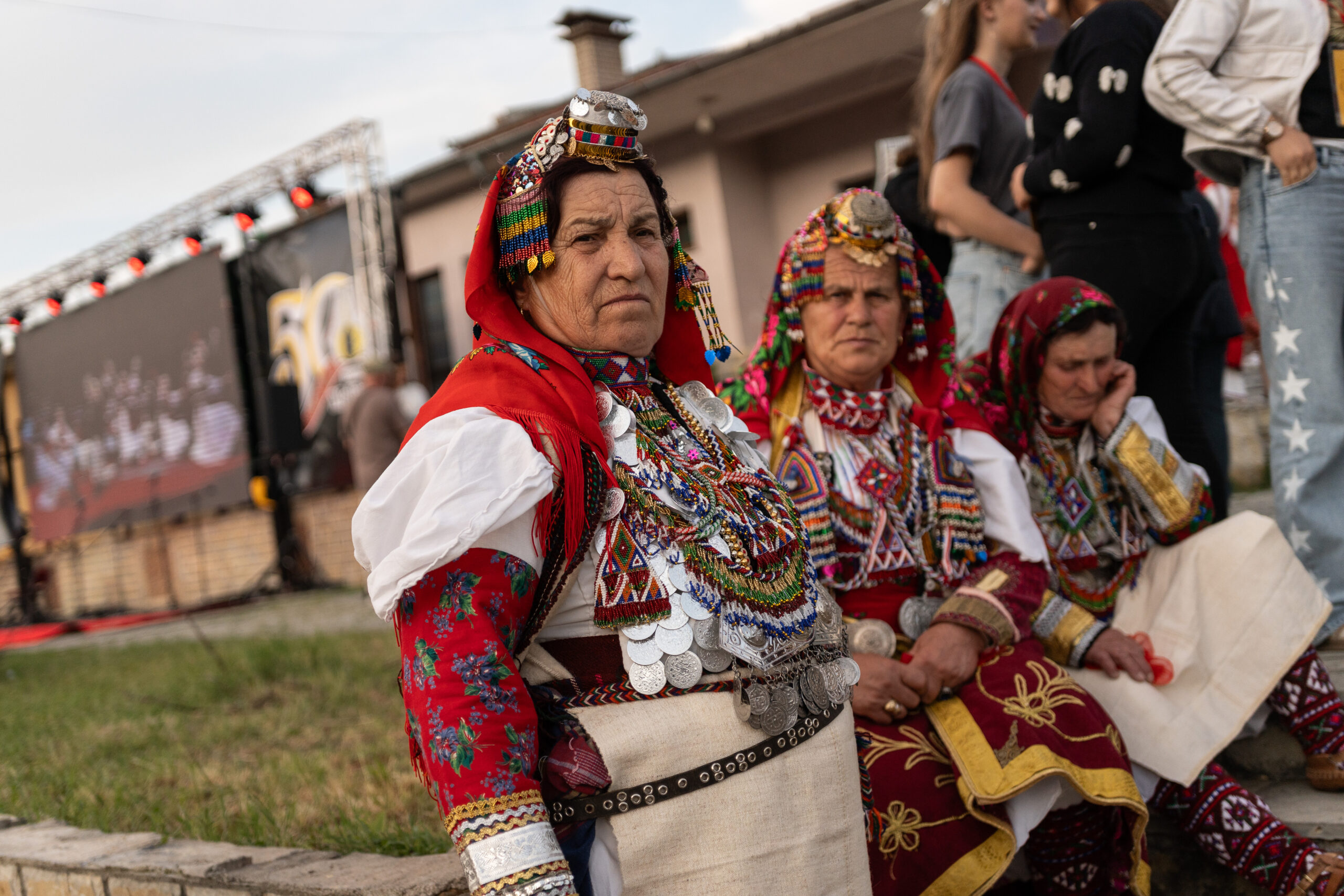
This festival has been held in Gjonaj since 1976 and originally brought together groups from villages in and around the city of Prizren. It was first organized by the Malësori Cultural-Artistic Society, which was founded by students from Hasi attending the Higher Pedagogical School in Prizren, with the aim of promoting their folklore.


Shortly before six in the evening, parades of women and men in national costumes became more frequent in front of the Reshat Çoçaj Cultural Center, starting from the nearby school. Haziz Hodaj, the ensemble’s director, and Dilaver Kryeziu, the artistic director, were constantly on the move — whether in the hall inside the cultural center, outside coordinating with the sound crew or among the 18 participating ensembles and groups.
Since the post-war period, Hasi Jehon has established itself as a major cultural event that, over three consecutive days, brings together ensembles and artists from various Albanian-inhabited regions. The festival attracts around 10,000 visitors and features approximately 20 ensembles from Kosovo, Albania, North Macedonia, Montenegro and the diaspora. They showcase traditional songs, dances and rituals. The event also includes exhibitions of traditional clothing, crafts and local products — such as Hasjan bread.

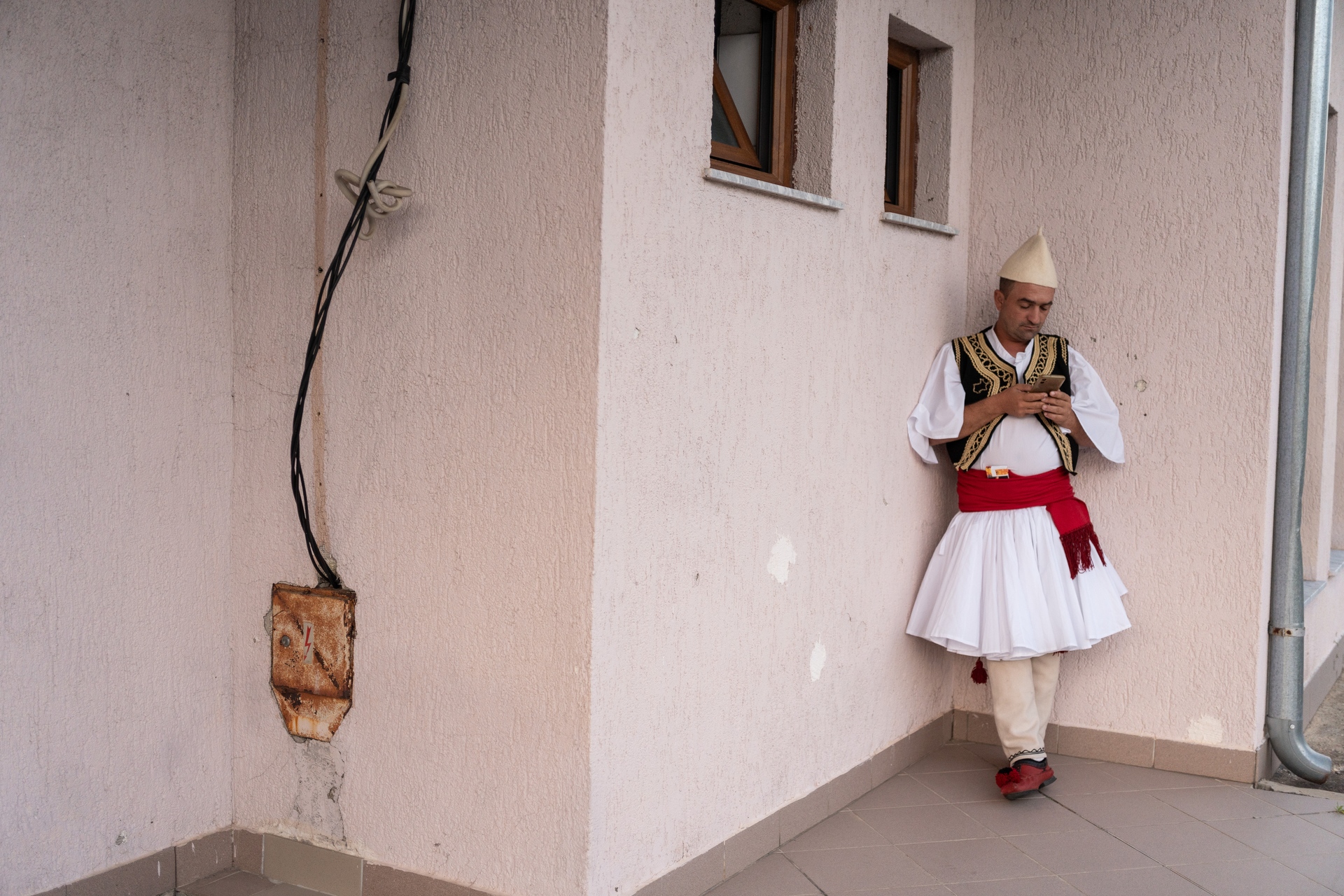
The annual dates of the festival, May 2 to May 4, are rooted in the blood feud reconciliation movement led by folklorist and professor Anton Çetta. In 1990, Çetta initiated a campaign to reconcile blood feuds among Albanians in Kosovo. Often referred to as the “wise old man,” he mobilized students, intellectuals and community leaders to promote peace and forgiveness, directly challenging the deeply rooted tradition of blood feuds governed by the Kanun of Lekë Dukagjini, which was still in effect at the time.
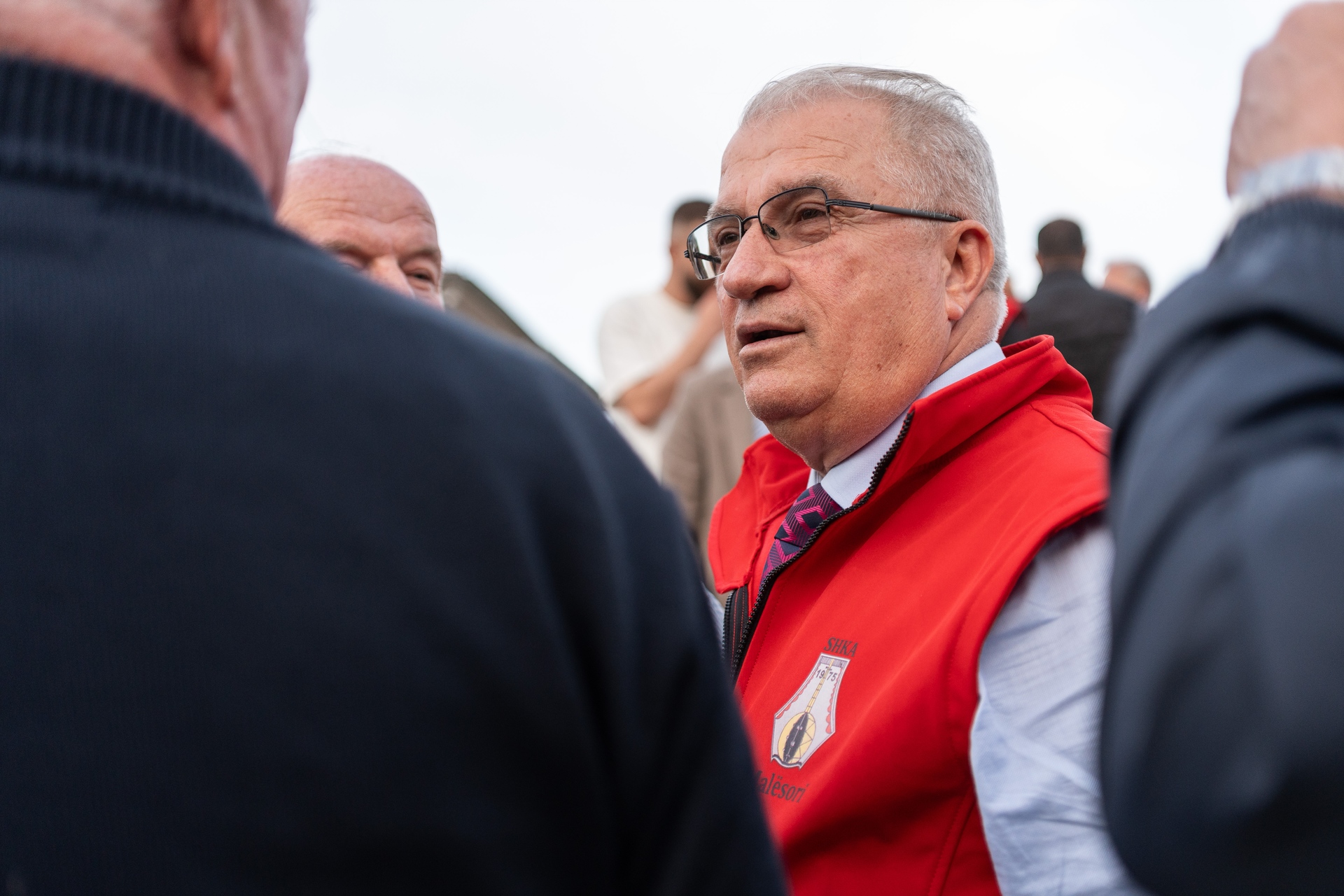
His efforts culminated in massive rallies, resulting in the reconciliation of over 1,000 blood feuds and other disputes by 1991. The initiative aimed to unify Albanians in order to strengthen resistance against the Serbian regime, which at the time was intensifying its repressive measures.
On May 2, 1990, this process took place in the village of Gjonaj, in what is now known as the Field of Reconciliation, where families from the Has area extended a hand of forgiveness to one another through Çetta’s mediation.
Today, a festival is held on the same site to commemorate this act of reconciliation through celebration and cultural remembrance.
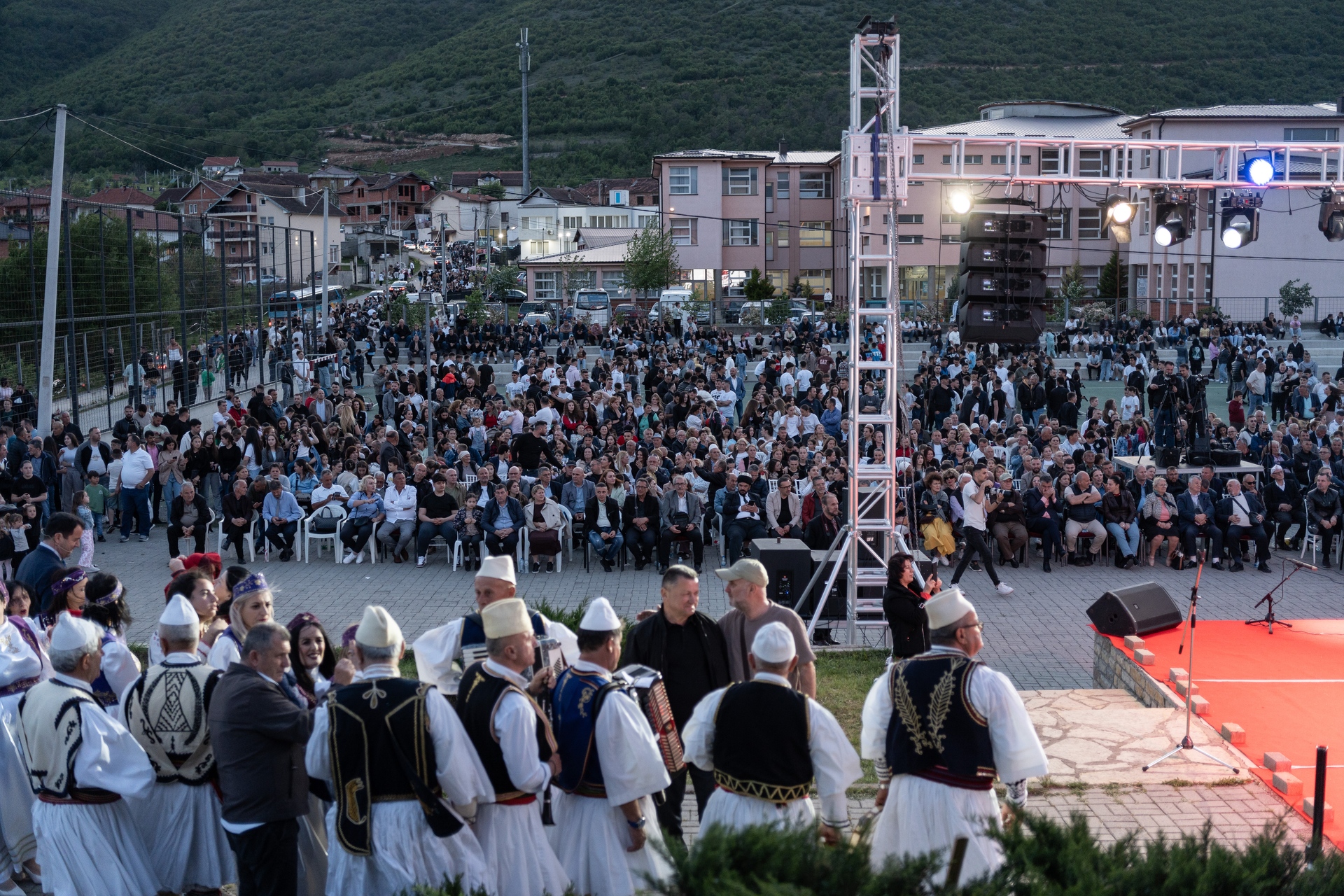
In its early days, the festival was not held regularly and was interrupted during the years of the war in Kosovo. According to Hodaj, the post-war period marked the most difficult time for organizing the festival. Hundreds of families in Gjonaj were left living in tents in the early 2000s, after about 800 houses were burned down.
However, in 2000, the community made efforts to revive the festival with support from the German KFOR, which helped build a wooden stage. In 2001, the festival expanded to a regional level and became an annual event. Since 2022, Hasi Jehon has been declared a State Protected Asset — a status that recognizes its importance in preserving the country’s cultural identity. The festival is financed by the Ministry of Culture, Youth and Sports and the Municipality of Prizren, with additional support from private donors.
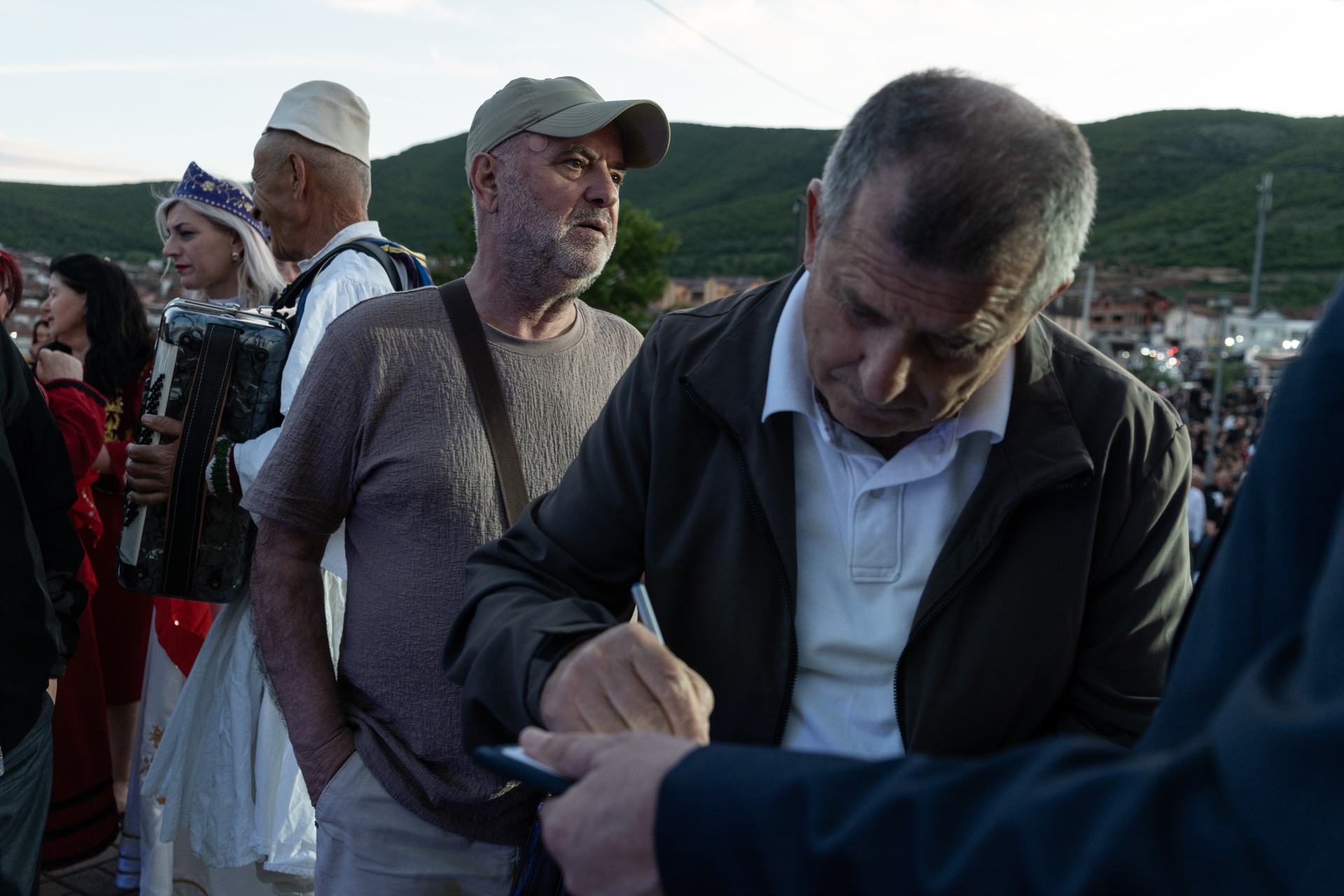
Kryeziu, the artistic director and a renowned name in the field of choreography, collaborates with a team each year to select ensembles that meet the festival’s criteria, ensuring high-quality performances. This process requires preparations for the next edition to begin immediately after the current one ends, demanding a full year of work and dedication.
According to Kryeziu, the main criterion for selection is the originality of the performances, songs and dances must be authentic and unaltered, reflecting the true heritage of their respective regions. During the three-day festival, the selected ensembles perform traditional songs and dances in original regional costumes, drawing thousands of citizens who gather to celebrate this cultural event.
Counted decades on stage

This year, the artistic selection brought together 18 ensembles from across the region, spanning from southern Albania to the villages of Tuzi in Montenegro, creating a rich mosaic of cultural heritage. One after another, the stage came alive with traditional costumes and age-old dances. In this edition, a total of 44 dance performances were presented by various ensembles.
The groups waited for their turn to take the stage. Gathered in a corner near the platform, the presence of Lajde Kolgjeraj stood out, the director of the Katarina Josipi Ethno-Musical Ensemble from Zym , which has been active in the folklore scene for more than four decades.
Her outfit, made by the women of the region, featured a white shirt of thick fabric, carefully embroidered with colorful floral motifs around the chest. Over the shirt, she wore a black vest adorned with gold piping and red details, while a traditional red scarf with colorful flowers was tied around her head.
Kolgjeraj, 57, has been involved with the ensemble for most of her life. “After the war, I revived the ensemble by gathering the old members I knew from before, and I’ve continually included new generations, teaching them all the customs and traditions,” she says. However, she expresses concern about the difficulty of maintaining the ensemble with the same members due to the migration of young men and women from Zym, either to urban areas or abroad, as well as a growing lack of interest in joining the group.
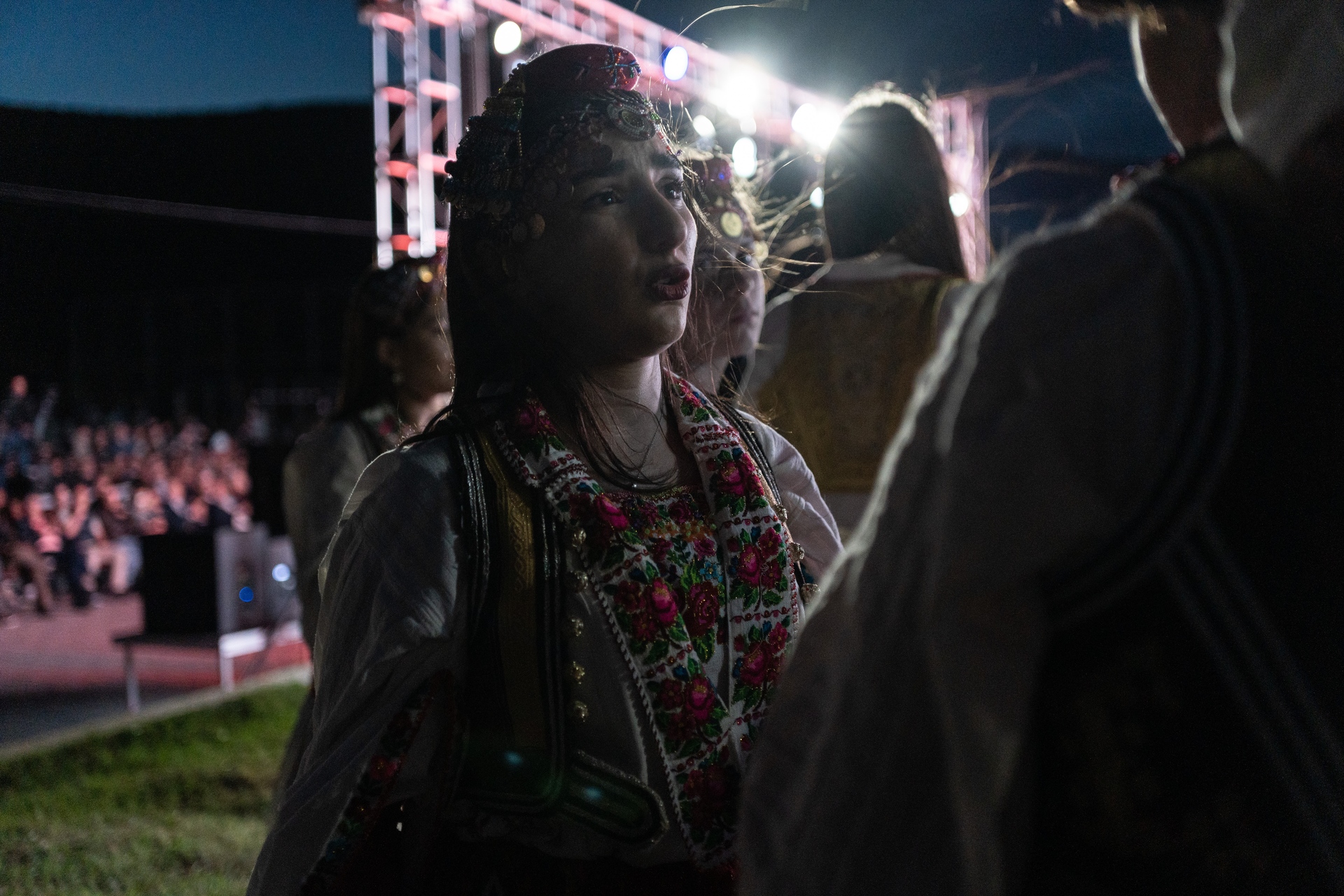

Many ensembles in Kosovo lack sustainable funding and operate with the status of nongovernmental organizations. Although they were once — along with sports clubs and amateur theater troupes — an attractive space for young people, this has changed significantly due to the availability of other activities and the digitalization of everyday life.
In the past, young dancers were often recruited from primary schools, where choreographers would scout for students with potential. However, the passion for participating in an ensemble often fades with age, especially in the absence of stable financial support. At times, ensembles are forced to fill their ranks with other villagers who are not actively involved in the group.
In Kosovo, only the state ensemble Shota receives financial support from the Ministry of Culture, Youth and Sports, as it has been designated a special category under the Law on Salaries.
Amidst all these challenges, the festival — and Kolgjeraj’s song — continues. As the def dajre, a traditional hand tambourine, rings out, the girls gather and the singing begins. The sound of the Ladja echoes, followed by the men performing the traditional Hasjan wedding dance known as burrnishte. Behind the stage, Behar Hoxha ran his fingers over the many holes of his clarinet, playing a familiar melody. Hoxha had traveled from Berat with the Qupërlinjtë e Roshnikut Cultural-Artistic Society.

Since 2002, he has attended festivals in Kosovo several times. Known by his stage name The Vrioni Nightingale, Hoxha has spent his life with a clarinet in hand and has been performing on festival stages for 56 years.
“I was 14 when I first went on stage at my first festival in Gjitokaster,” says Hoxha, already dressed in his costume, ready to perform. “Since then, I have never left the stage, and together with my four brothers, we have represented Berat everywhere.”
Hoxha fills the stage. An artist plays the def dajre, while four older men begin a traditional dance — dropping to their knees, then quickly rising and circling around. For a few minutes, the stage belongs entirely to Hoxha. The round scarf tied around his waist expands as he catches his breath, and the clarinet releases the sound of a familiar kabaja, as clarinet melodies are called in southern Albania.
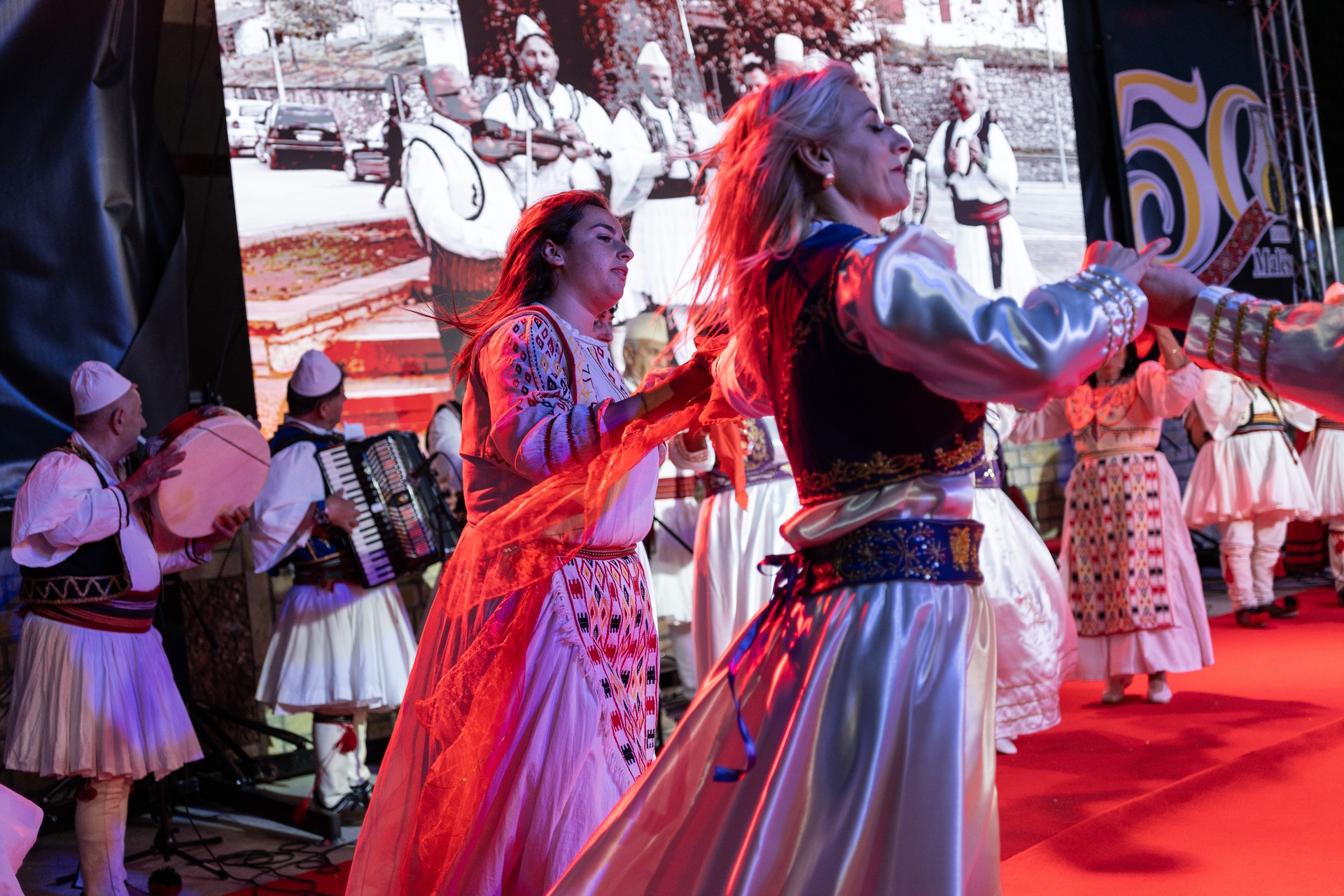

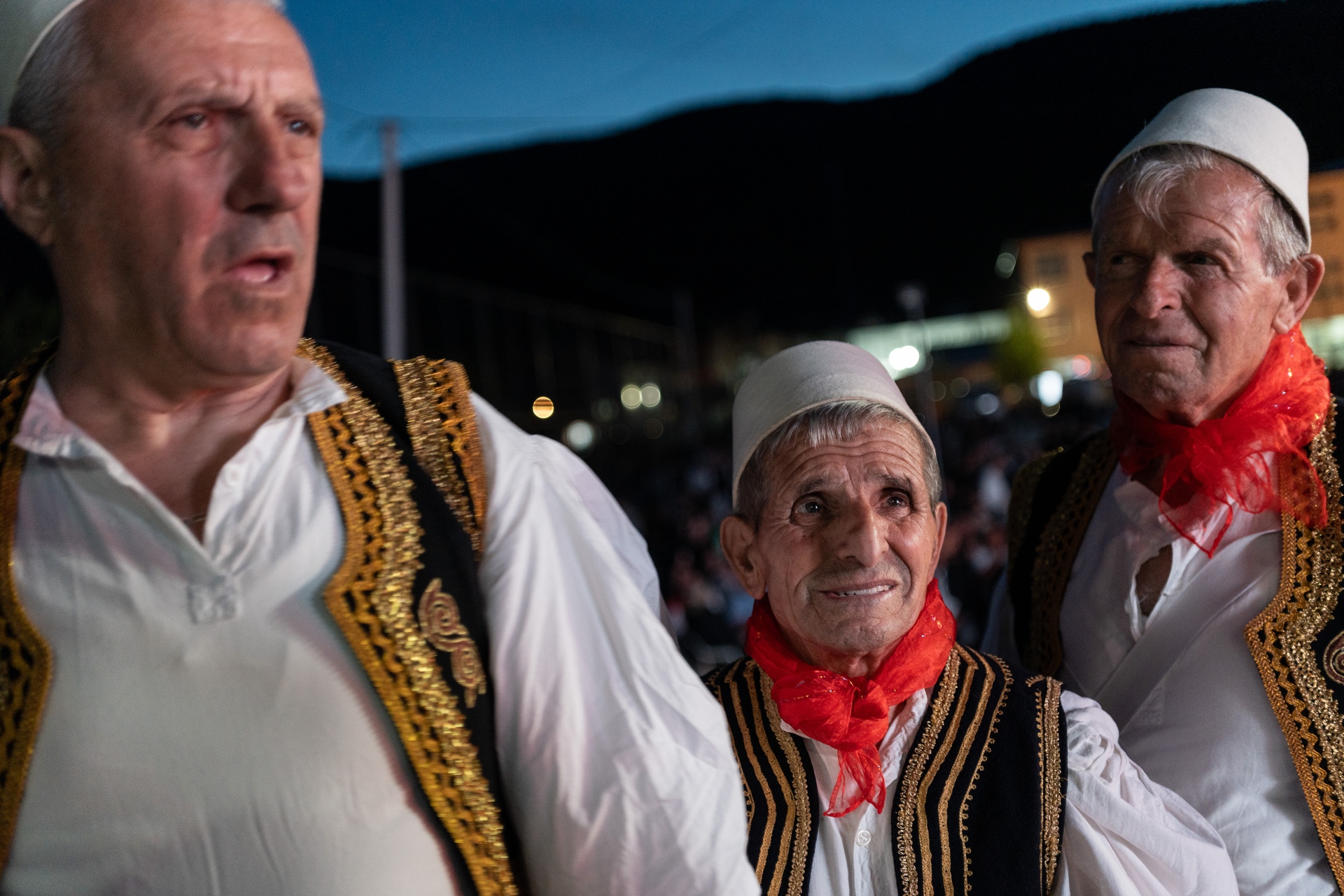
It was the instrumental piece “Kaba e Halit Beratit”, featured in the film “General Gramafoni,” one of the iconic works of Albanian cinematography. The film is set in 1930s Albania, on the eve of the Italian invasion in 1939. Halit Berati, portrayed by actor Bujar Lako, is a clarinetist and oil worker who faces pressure to abandon traditional Albanian music in favor of Italian fascist-era melodies. This attempt to control Albanian culture is met with Halit’s firm refusal. Through his performances, he resists and preserves cultural identity. At the Hasi Jehon festival, the performance of Halit Berati’s kaba also feels like an act of resistance — a continued insistence on preserving cultural heritage.
From the lute to touching the sky with one’s hand
The stage of Hasi Jehon changed ensembles day after day. It wasn’t always filled with dancing.
The next day, a duo performing through sound and words was preparing to take the stage. Nazmi Hajdari and Muzafer Osmani, both from Ferizaj, sat side by side. Nazmi held his lute in his hands, adjusting a bridge on the strings to find the dyzen — the perfect tone.

He was returning to Hasi with the lute, although he had started his career with the çifteli.
“I’ve been a rhapsodist since childhood. When I grew a bit older and started singing at weddings with the çifteli, I performed a lot here,” says Hajdari. “There wasn’t a village or neighborhood I didn’t visit.”
With a hint of resentment, he had begun to take up the lute, fearing that its art was disappearing.
“I saw that the number of lute players was decreasing day by day. I got upset and decided to learn it, and now, after 20 years of never parting from it, I’m teaching it to my great-grandchild,” says Hajdari.
Hajdari wore traditional attire from the Rugova region: tirqi, the traditional woolen pants, a vest and a scarf tied around his waist, with a Rugova qallmë on his head. The two of them stepped onto the stage, Hajdari approached the microphone, placed one hand behind his ear and began shouting loudly in the Rugova style. “I’m honored to be here, brothers from Has — a great celebration, ‘Hasi Jehon!’” He raised his voice so much that everyone turned their heads toward the stage, anyone distracted by their phone screen was startled.
When he finished, Osmani began telling an anecdote, weaving in the words of elders with reflections on current events. With the alternation of lutes and anecdotes, their performance brought a welcome variety to the stage.
As they left the stage to applause, other dancers from the Anamorava Cultural Center in Vitia were getting ready.
Getuar Sadiku, 16, and Meriton Xheladini, 17, were preparing for the duet dance of Karadak and Anamorava. Sadiku has been part of the cultural center since the age of 10, while Xheladini joined just a year ago.
“I saw them dancing on TV once and thought, why not join in? Today I feel great seeing the audience waiting for us like this,” says Xheladini. Both he and Sadiku agree that, at family gatherings and weddings, they are now always the first to start dancing.
They both follow the lead of Bardhyl Osmani, the main soloist of the traditional men’s dance from Karadak. Unlike the other dancers in white shirts, Osmani wore a black shirt that made his red vest, crafted from black corduroy, stand out even more. He has been dancing since the age of 10.
The dance begins with the men standing side by side, kept in sync by the steady rhythm of the drum. As the rhythm shifts slightly and brief pauses mark the transitions, Osmani steps into action. Taking the hand of the friend beside him, he moves to the center of the stage with only the drum accompanying him. While leaping into the air, his partner grabs his arm and he lands dramatically on the stage, striking the floor with his hand in time with the drumbeat.

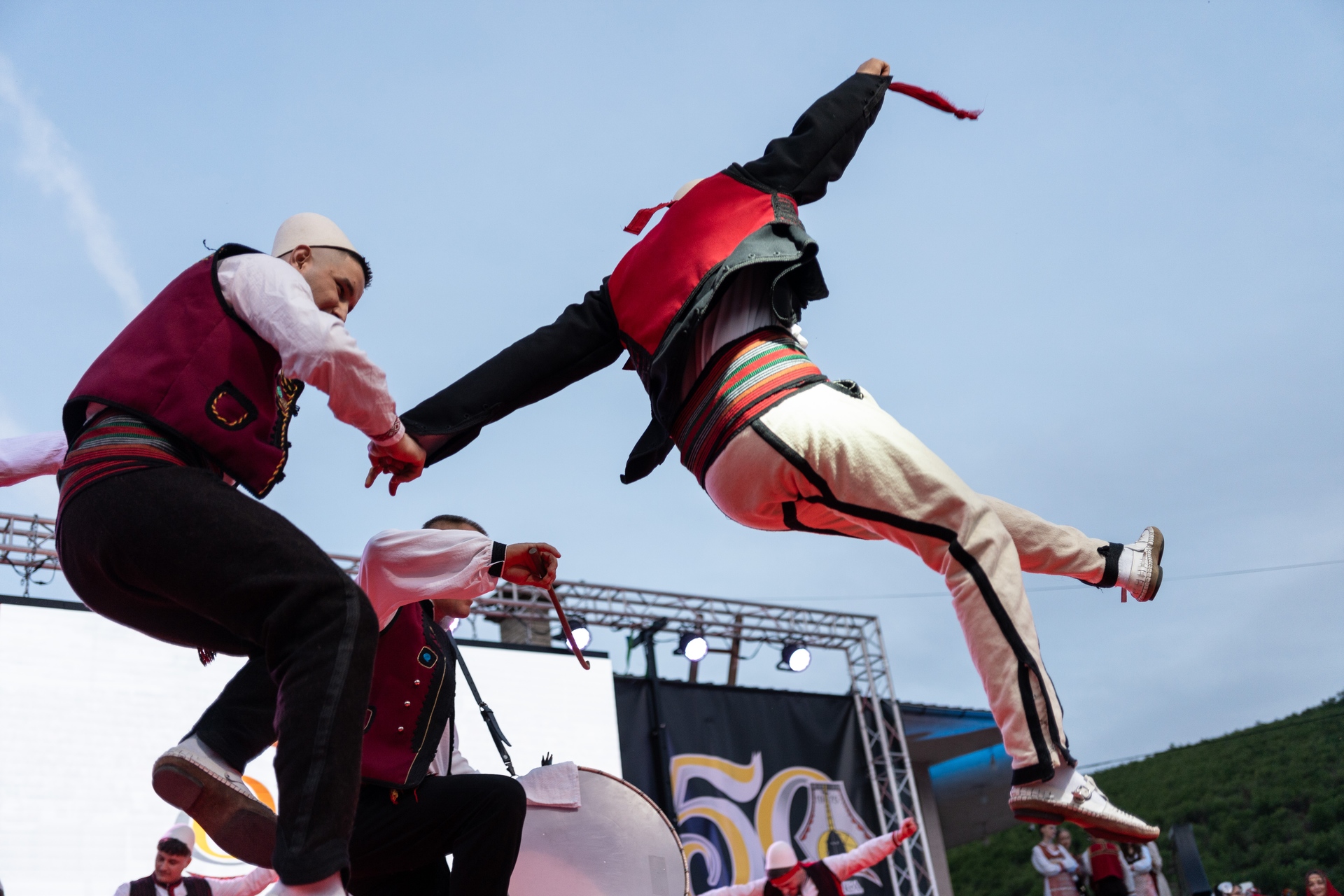
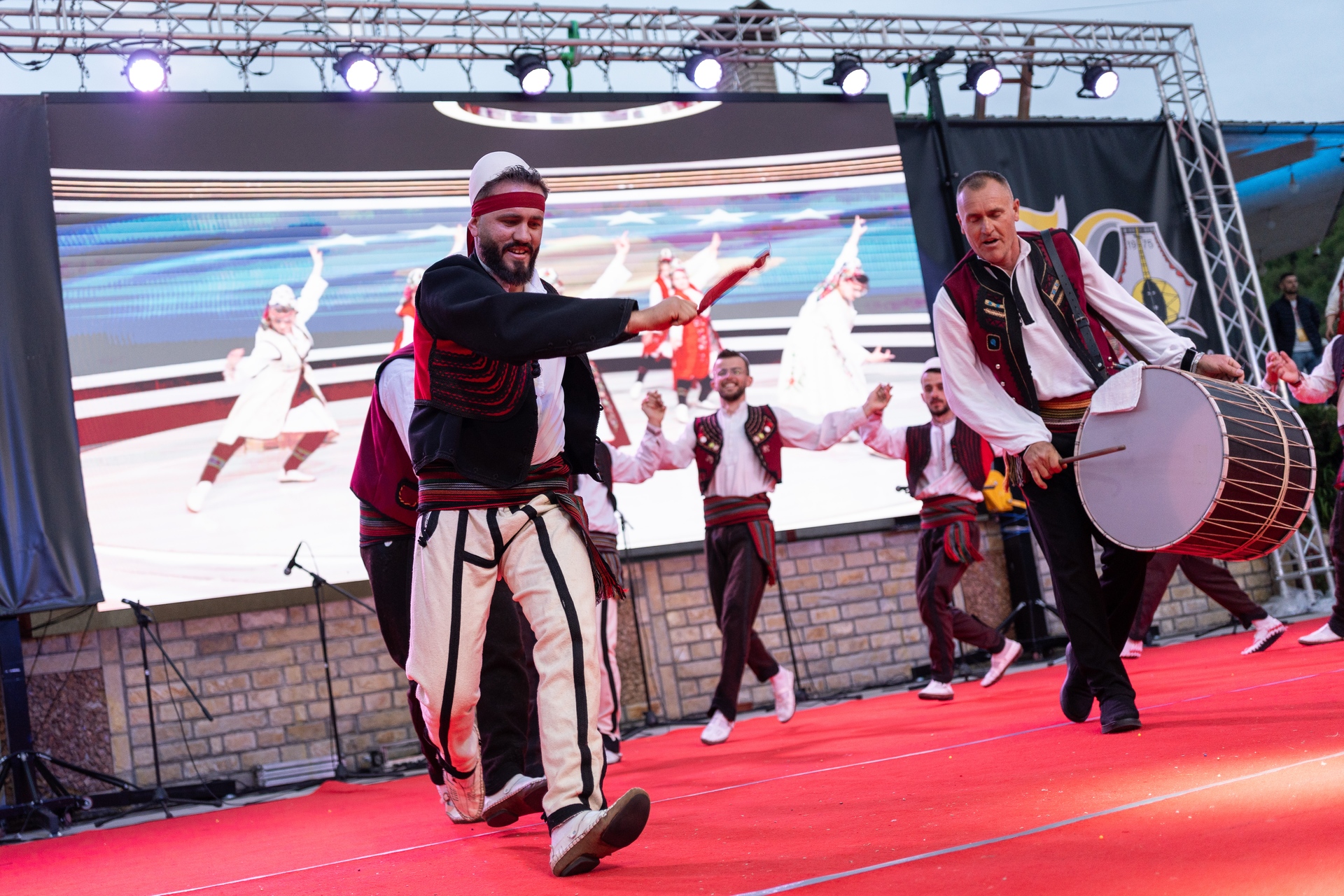
The stage was on fire as the drum of Anamorava echoed deep into Has. With just a few swift movements, Osmani found himself in his friend’s arms, one atop the other. He removed his plis and greeted the audience, concluding the performance of the troupe from Vitia.
“These dances are part of our family heritage. I’ve seen all my relatives perform them, and we will keep dancing them,” he said, breathless after his performance. “This is my third time in Hasi, and we’ve been preparing for this performance for months.”
His powerful performance earned him the title of best dancer at this year’s edition of the festival.
Hasi welcomed and bid farewell to hundreds of dancers and instrumentalists — just as it will welcome them again next year.
“We kept it going even when we were burned and killed after the war, and now no one can stop it,” says director Hodaj, among other things.
Photos: Ferdi Limani / K2.0.

This article was published with the financial support of the European Union as part of the project “Diversifying voices in journalism.” Its contents are the sole responsibility of Kosovo 2.0 and do not necessarily reflect the views of the European Union.
Dëshironi të mbështetni gazetarinë tonë?
Në Kosovo 2.0, përpiqemi të jemi shtyllë e gazetarisë së pavarur e me cilësi të lartë, në një epokë ku është gjithnjë e më sfiduese t’i mbash këto standarde dhe ta ndjekësh të vërtetën dhe llogaridhënien pa u frikësuar. Për ta siguruar pavarësinë tonë të vazhdueshme, po prezantojmë HIVE, modelin tonë të ri të anëtarësimit, i cili u ofron atyre që e vlerësojnë gazetarinë tonë, mundësinë të kontribuojnë e bëhen pjesë e misionit tonë.
Anëtarësohuni në “HIVE” ose konsideroni një donacion.
